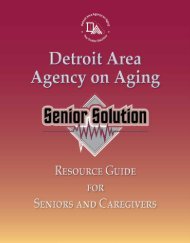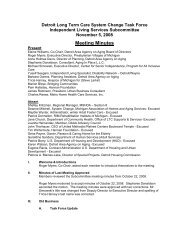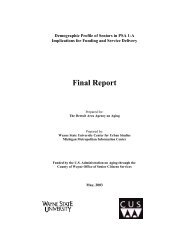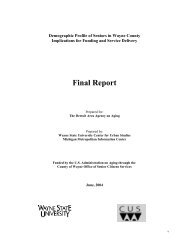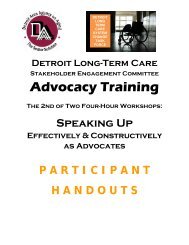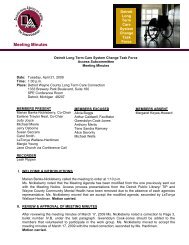DAAA Skilled Nursing Facility Analysis Executive Summary
DAAA Skilled Nursing Facility Analysis Executive Summary
DAAA Skilled Nursing Facility Analysis Executive Summary
You also want an ePaper? Increase the reach of your titles
YUMPU automatically turns print PDFs into web optimized ePapers that Google loves.
City of Detroit<br />
<strong>Skilled</strong> <strong>Nursing</strong> Facilities<br />
A total of 4370 licensed beds in 36 Medicaid<br />
certified facilities are available in the <strong>DAAA</strong>’s<br />
service area, including Highland Park, Harper<br />
Woods and the Grosse Pointes. There is one<br />
facility that is not certified for Medicaid.<br />
• There is significant ownership of beds<br />
by four entities (56%)<br />
• The predominance of ownership is by<br />
proprietary organizations. There are<br />
only five not-for-profit facilities.<br />
• There are significant clusters of<br />
facilities (Sector 3 serving the city’s<br />
east side and Sector 9 serving the<br />
northwest). There are some sectors<br />
with little to no bed capacity.<br />
Detroit Area Agency on Aging Service<br />
Area<br />
2 5<br />
2<br />
3<br />
1<br />
3<br />
3 1<br />
# = Number of <strong>Skilled</strong> <strong>Nursing</strong> Facilities<br />
NORTHERN REGION = 10 SNF’s<br />
• Sectors 1, 2, 10, 11, 12<br />
0<br />
(1276 beds)<br />
SOUTHERN REGION = 5 SNF’s<br />
• Sectors 4, 5, 6 (629 beds)<br />
EASTERN REGION = 13 SNF’s<br />
• Sector 3 (1218 beds)<br />
<strong>Summary</strong> of Significant Findings<br />
2<br />
1<br />
3<br />
Michigan. These groups include adult,<br />
non-elderly residents, HIV dependent<br />
and homeless individuals, and<br />
persons with chronic mental health,<br />
substance abuse and behavior issues.<br />
We also noted a very high incidence of<br />
residents with wounds and infections<br />
as compared to other facilities.<br />
• Medicaid utilization in Detroit is higher<br />
than Michigan averages.<br />
• Medicare utilization in Detroit is less<br />
than Wayne County and Michigan<br />
averages. There is a strong correlation<br />
between higher Medicare utilization<br />
and favorable financial results. Many<br />
of the facilities indicated difficulty in<br />
accessing Medicare residents through<br />
the hospital discharge process.<br />
• Occupancy in Detroit is less than<br />
Michigan averages. Occupancy is<br />
lowest in the Eastern Regions where<br />
there appears to be excess capacity.<br />
• A significant number of patients are<br />
sent to the hospital when they could<br />
be cared for at the nursing home due<br />
to the lack of adequately trained staff.<br />
As a result, both Medicaid and<br />
Medicare incur higher costs to care for<br />
these patients.<br />
• Medicare Special Needs Plans<br />
(Fidelis) have enrolled many Detroit<br />
Medicaid residents in their Part A<br />
Advantage Plans. They provide onsite<br />
case management and caregiver<br />
assistance for their enrollees. As a<br />
result, this may improve the overall<br />
quality of care in Detroit facilities and<br />
will likely reduce the rate of<br />
readmission to hospitals.<br />
<strong>Facility</strong> Occupancy<br />
92.00%<br />
90.00%<br />
88.00%<br />
86.00%<br />
84.00%<br />
Patient Profiles and <strong>Facility</strong> Capacity<br />
• The Detroit SNFs have a significant<br />
population of patients atypical to the<br />
average long term care facility in<br />
82.00%<br />
80.00%<br />
Western<br />
Region<br />
Michigan<br />
Average<br />
Southern<br />
Region<br />
Northern<br />
Region<br />
Wayne<br />
County<br />
Average<br />
Eastern<br />
Region<br />
2



